Suppose you build a time machine and travel 600 years into the future — and discover that people in 2623 will happily consume whole raw onions and garlic cloves as snacks. That will give you an idea of what someone from 1423 would think about us popping grapes directly into our mouths.
How can I compare grapes to onions and garlic? Well, until the early 16th century, people didn’t eat grapes; they just made them into wine. The first person to popularize table grapes as a food in their own right was French king Francois I, whose dessert of choice was a nice bowl of Chasselas grapes.
Table grapes are no longer the royal novelty they once were. But even so, most grapes grown today still end up in wine bottles. Only 12% of grapes find their way to our tables whole and fresh. And because they’re expensive to transport, most of them get consumed in their country of origin — largely in Europe and North America.
If you live in a place where fresh grapes are available, they can bring a natural sweetness to your diet. You can just put a bunch on a plate and enjoy a dessert literally fit for a king. You can freeze them, add them to sweet and savory recipes, and enjoy them in cool summer beverages. (Having them peeled and fed to you while you recline on a divan is totally optional.)
To get the most out of this delicious and fragile fruit, however, you need to know how to choose, store, and clean them to preserve their flavor and maximize their freshness.
In this article, we’ll explore the best practices for handling grapes to ensure they remain at their best. And you’ll also get seven delicious recipes that incorporate different varieties of grapes.
When Are Grapes in Season?

Grapes ripen in the summer and fall, so you can find them fresh and local (at least if you consider the same hemisphere local) from July through November. If you have growing space and live in USDA zones 4–10, you may also be able to grow your own grape vines if you desire. Some varieties prefer cooler temperatures, while others thrive in the heat.
In addition to growing your own grapes, you can also find table grapes in grocery stores, natural foods stores, farmers markets, and community-supported agriculture (CSAs).
Globally, three Mediterranean countries dominate the grape trade: Italy, Spain, and France. In the US, California is where the vast majority of grapes are grown. (A lot of California grapes also end up as raisins. I’d make a joke about this, but my sense of humor isn’t that dry.)
How to Choose Grapes
Unlike lots of other kinds of fruit, grapes don’t ripen after picking, so look for grapes that are at their peak of sweetness: plump, well-rounded, and firm to the touch. Avoid ones that look shriveled, or have wrinkles or soft spots. The stems of grapes should be green and flexible. And don’t be put off by any powdery film on the surface of the grape’s skin — that visible bloom is a sign of freshness.
Since grapes are typically sold in bunches, take a moment to check the entire bunch for signs of mold, bruises, or damaged fruit.
Although some popular types of table grapes may be available year-round, getting them when they’re in season ensures the freshest and tastiest fruit.
How to Store Grapes
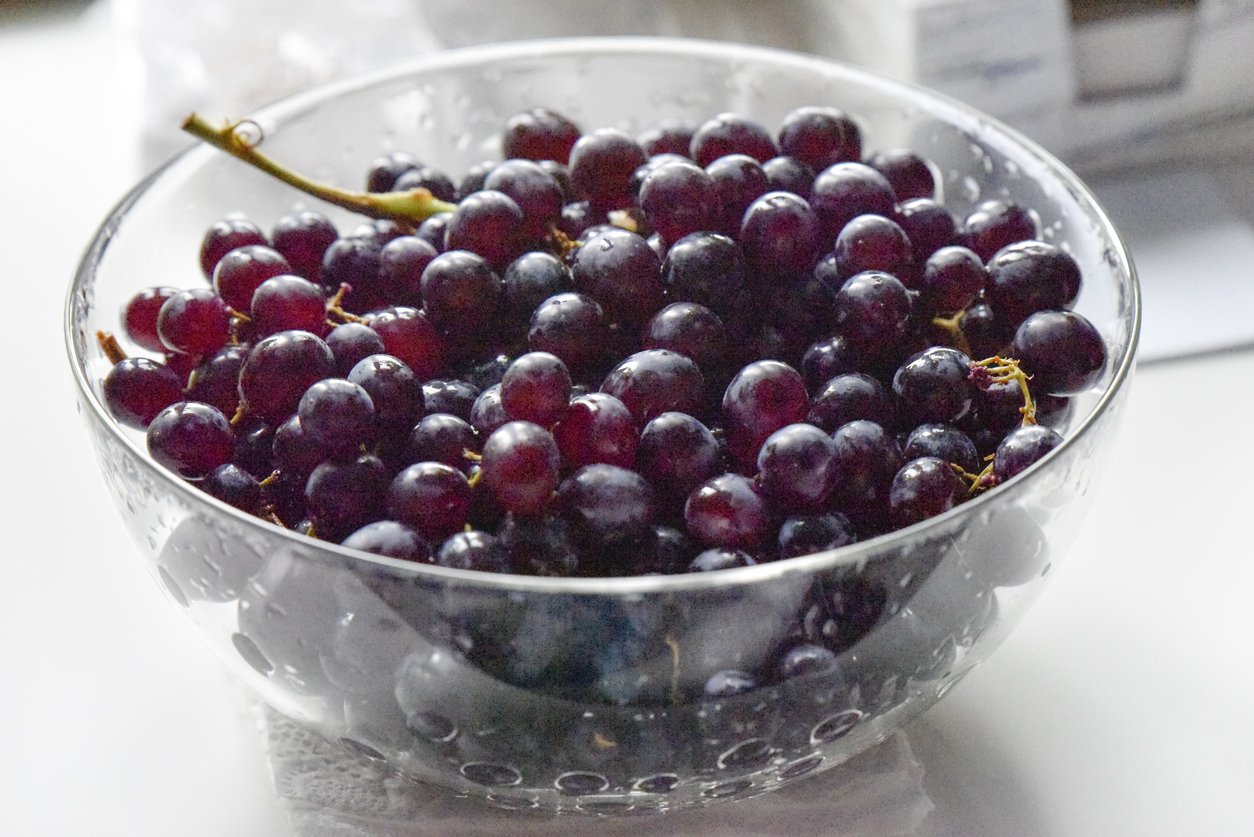
Once you get your grapes home, you can keep them fresh by storing them in your refrigerator, where they’ll keep for about two weeks. That said, my understanding of grape psychology tells me that they will start to grow sad and insecure after two or three days, wondering why you aren’t eating them.
In the fridge, you can prolong their freshness by storing them in a ventilated produce bag or an airtight container that’s free of moisture.
Out on the kitchen counter at room temperature, they’ll last three to five days, but I’d eat those grapes within a day or two for the best flavor and texture.
You can also freeze grapes, which will keep them for months. They get even sweeter when frozen, and develop a texture almost like ice cream, or a fruit popsicle. Just rinse them, pull the individual grapes off the stem, dry them, and place them individually on a cookie sheet (don’t let them touch each other to avoid clumping). Freeze the entire sheet, then put the grapes into a freezer-safe container and put them back in the freezer.
How to Clean Grapes
Unfortunately, nonorganic grapes typically have high levels of pesticide residues, earning them the dubious distinction of 8th place on the Environmental Working Group’s (EWG) Dirty Dozen list. According to the EWG, more than 90% of grape samples tested positive for residues of two or more pesticides. To avoid these chemicals, choose organic varieties whenever possible.
Regardless of whether you’ve got organic grapes or not, however, you’ll probably want to wash them to remove any dirt, pesticides, or bacteria that may be present on their skin. While there are plenty of commercial produce-washing products out there, current research points to a simple and inexpensive method as the most effective in removing pesticides: a solution of one ounce of baking soda dissolved in 100 ounces of water. Don’t just dunk and rinse, though; soak the grapes for 12–15 minutes for maximum pesticide elimination.
How to Eat Grapes
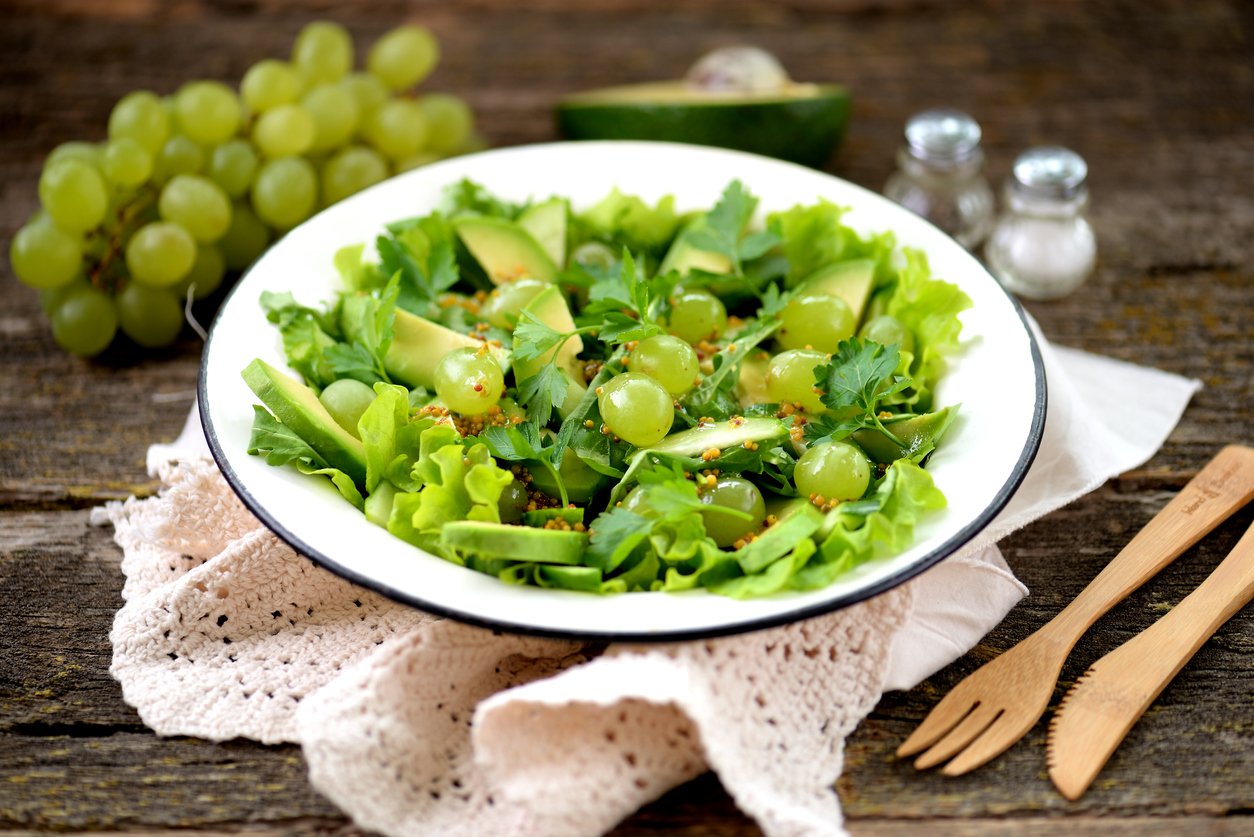
Grapes are great both raw and cooked. You can eat raw grapes by the handful, either fresh or frozen. (I’d slow down for the frozen ones, though. Pop them one at a time into your mouth and savor the flavor explosion as it warms up and releases its juicy sweetness.)
I don’t have any research to back this up, but I believe grapes actually taste better when you feed them to yourself, rather than hiring scantily-clad people to do it for you as you recline in luxury.
Cut in two, raw grapes can add sweetness and pizzazz to leafy green salads. Similarly rendered, they are great in fruit salads, where they get along with berries, bananas, and other fruits.
Blended, they act as natural sweeteners. You can add grapes to savory salsas, salad dressings, and sauces, as well as to sweet smoothies, smoothie bowls, and acai bowls.
Cooked, grapes make great jams and jellies. They’re naturally high in pectin (the gelling agent typically added to fruit jams), so all you have to do is remove the skins, cook down, add any additional sweetener if desired, cool, and can.
You can also roast them with vegetables for a delicious and eye-popping side dish or appetizer, and include them in cooked desserts and baked goods.
Grape Recipes
Kitchen creativity knows no bounds, especially when it comes to juicy grapes! In addition to eating them by the handful and spreading them on a lunchtime PB&J, there are so many other ways to enjoy these culinary chameleons. We’ve created seven delicious ways to experience grapes that will help you reap their health benefits at the same time. There’s a recipe here for everyone. So give these grape-riffic, plant-based recipes a try!
1. Vegan Feta and Grape Skewers
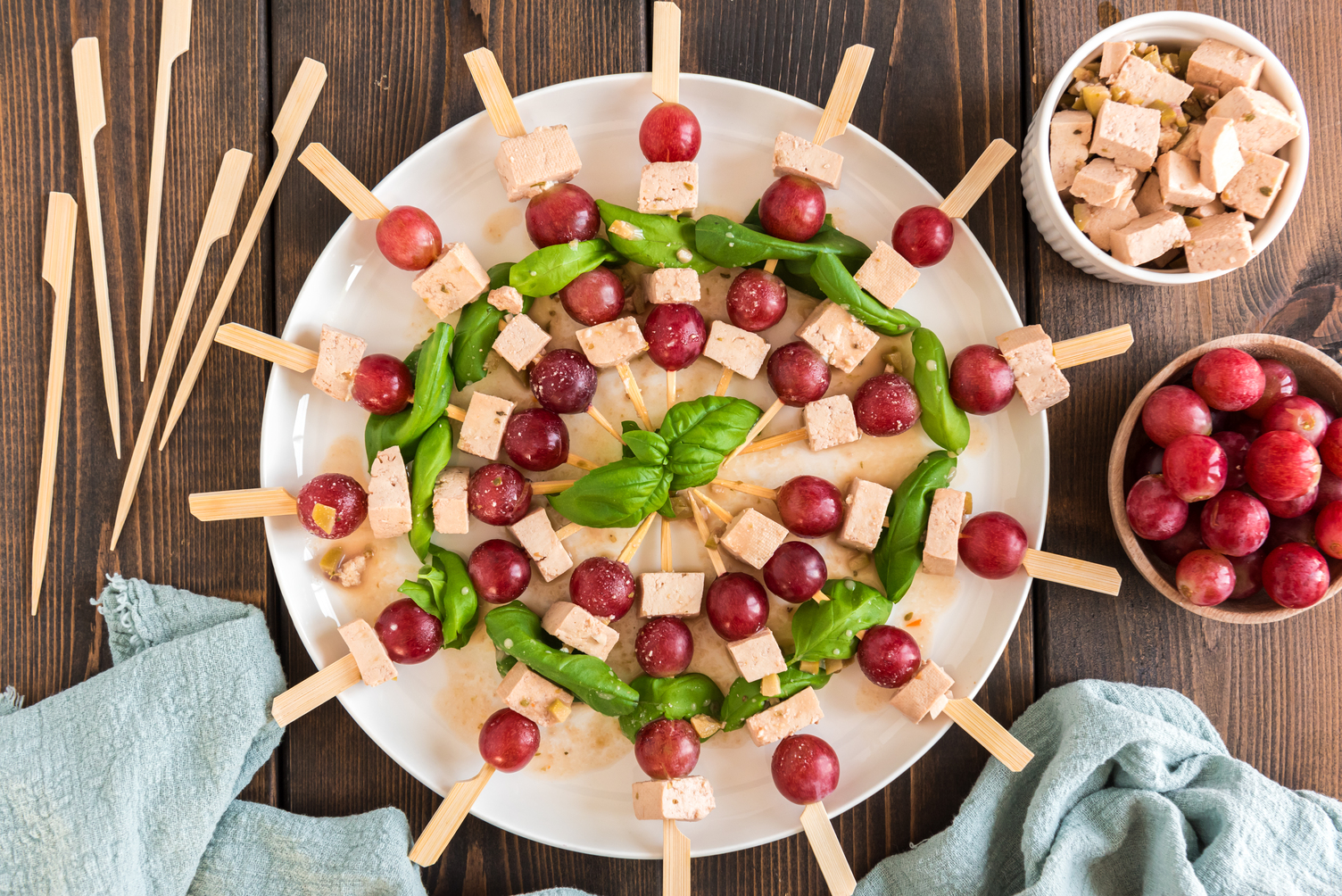
The texture of a grape is a delightful blend of soft juiciness with a delicate outer skin that provides a gentle snap as you bite into it. Now imagine, in the same bite, tangy vegan feta with a burst of fresh sweet basil. Vegan Feta and Grape Skewers balance savory and sweet in an all-in-one-bite appetizer that’s guaranteed to garner rave reviews!
2. Nourishing Grape and Chia Jam
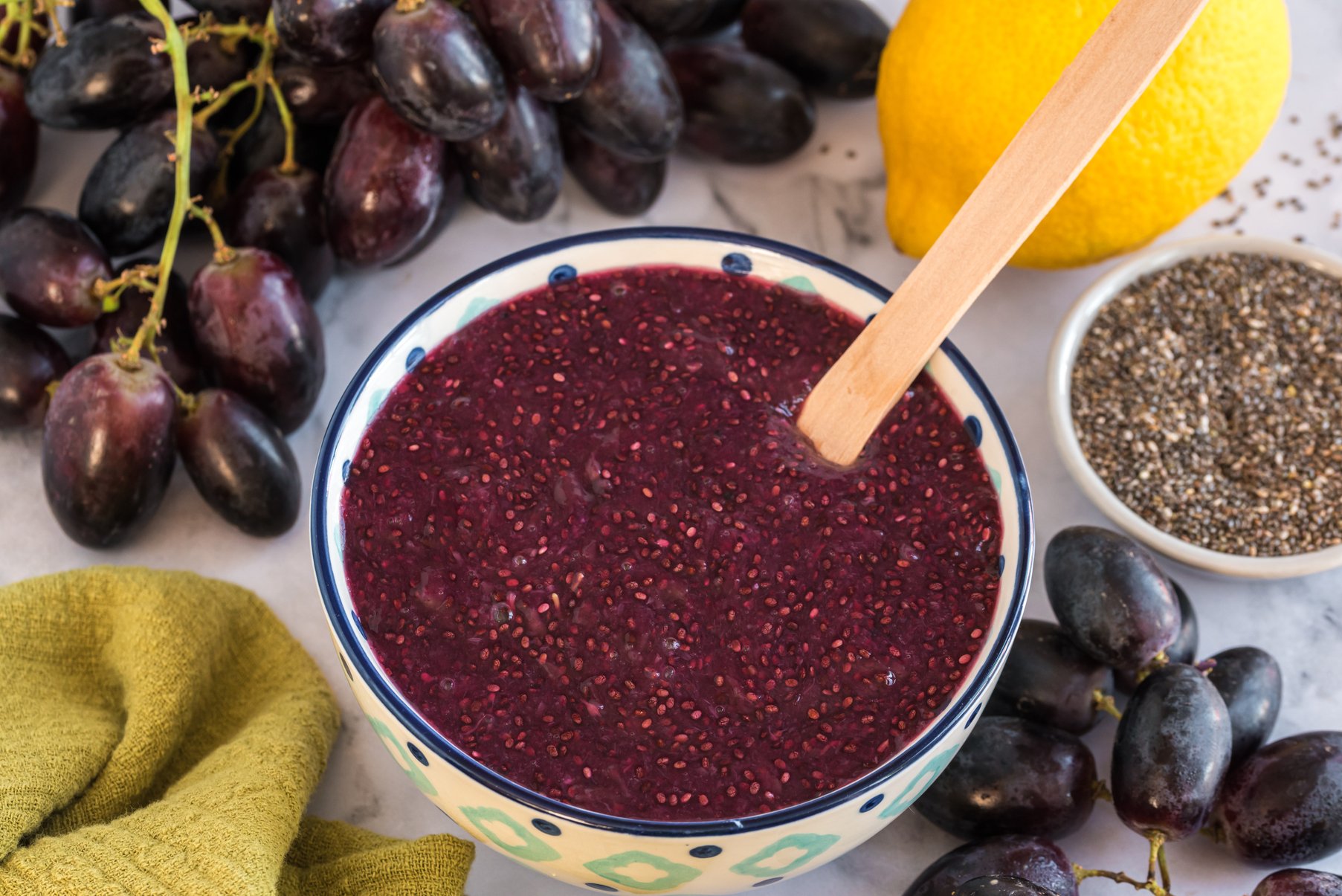
Nourishing Grape and Chia Jam is our version of a classic grape jam. By adding chia seeds (filled with lots of omega-3s) and maple syrup in place of white sugar, this jam is the perfect balance of sweet, tangy, and tart. Plus, the deep purple color (hello, anthocyanins!) is a gorgeous addition to your slice of toast or morning oats!
3. Refreshing Green Grape Slushie
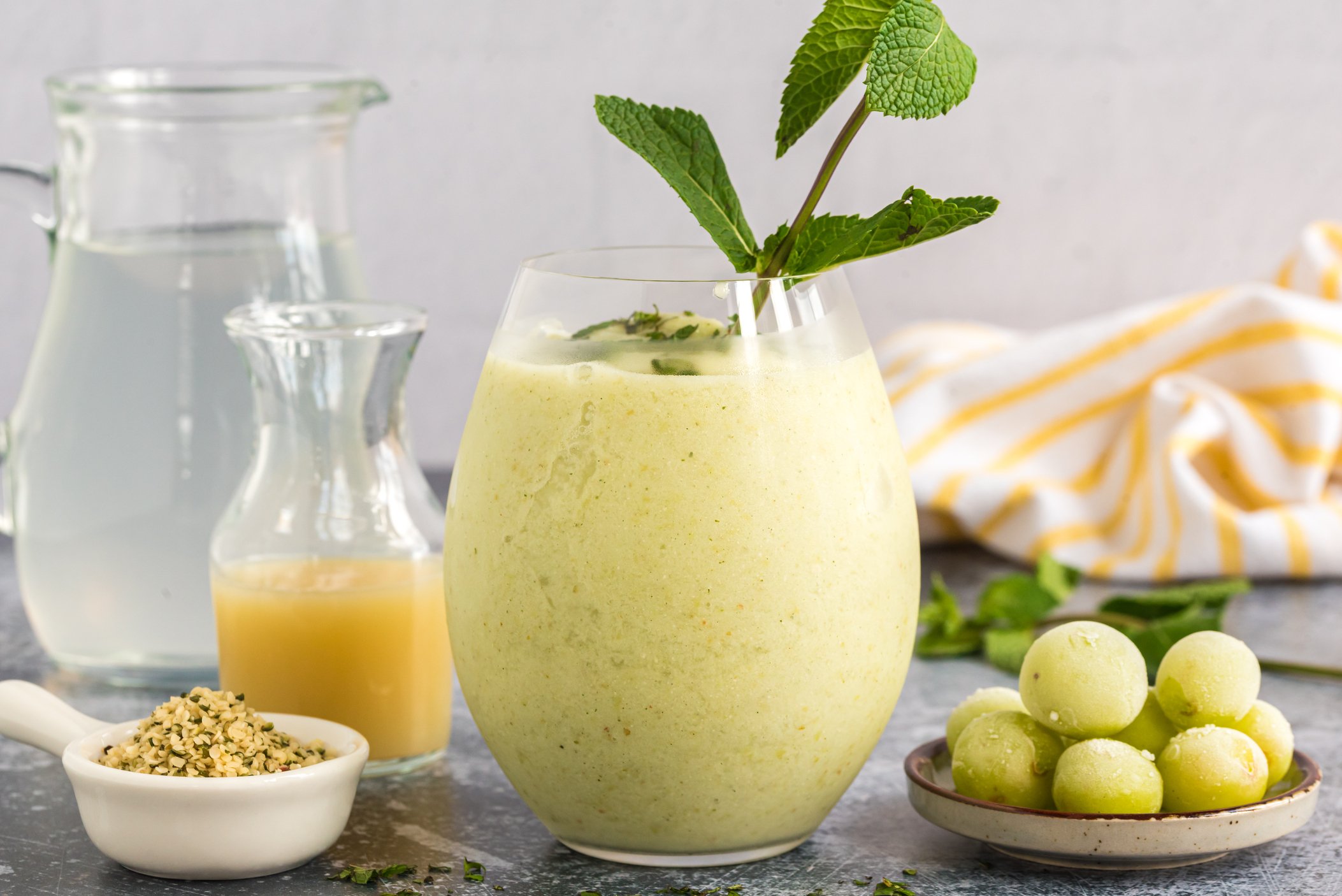
If green grapes are your preference, then we have the recipe for you! Beat the heat with this Refreshing Green Grape Slushie. A frosty, zingy, and tantalizing blend of lime, mint, and grapes, this vibrant slushie is a celebration of natural grape flavor in a cool and invigorating frozen treat!
4. Balsamic Roasted Brussels Sprouts and Grapes
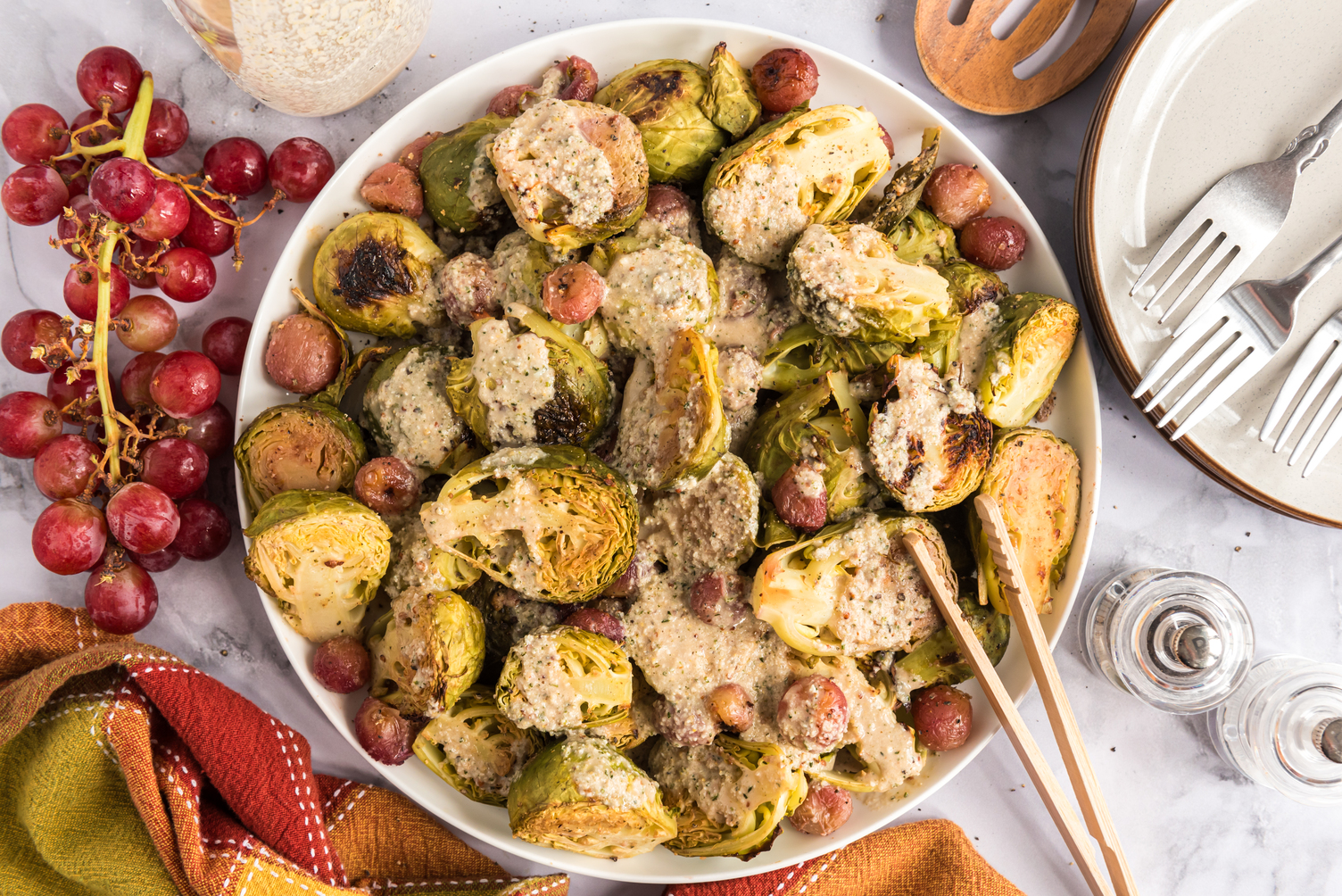
Roasted brussels sprouts and grapes take on a slightly caramelized flavor in this tantalizing side dish. Both the brussels sprouts and grapes develop a deeper flavor as they roast, making this a delicious side dish to complement a heartier meal. Pair it with grilled tofu or tempeh, or add to a savory grain bowl. What’s more, as the grapes begin to burst, their juices mix with the Balsamic Hemp Dressing to make a sweet and sticky coating on the Brussels sprouts that is out-of-this-world good!
5. Creamy Vegan Waldorf Salad
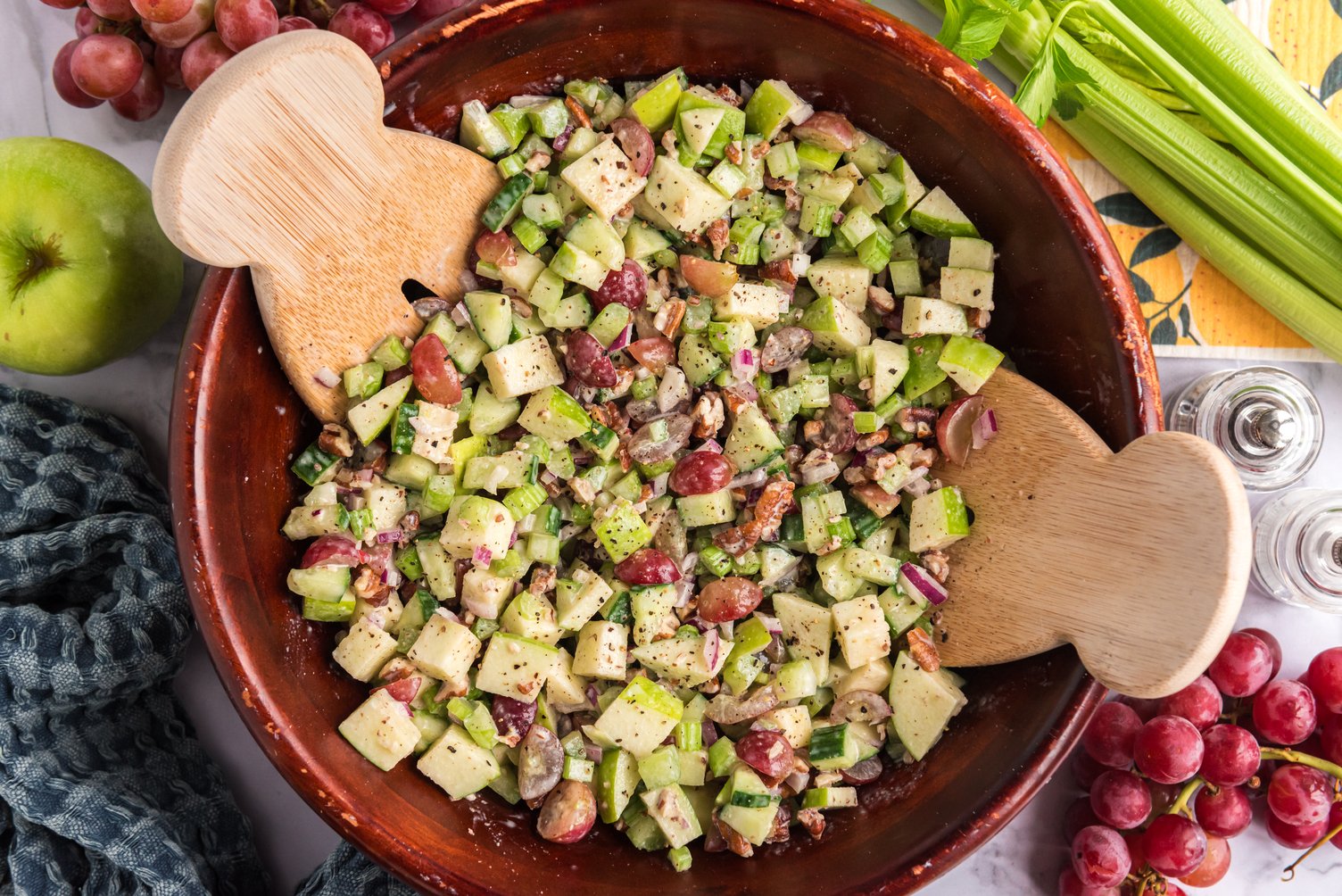
We may be biased, but juicy red grapes, toasted pecans, and a creamy yogurt dressing are a match made in heaven with this Creamy Vegan Waldorf Salad. This recipe is a delicious and refreshing way to enjoy grapes. Plus, it’s packed with phytonutrients from the grapes, healthy fats from the pecans, and probiotics from the dressing. If you’ve been looking for some sweet plant-spiration for grapes, then look no further than this heavenly recipe!
6. Roasted Grape, Grain, and Tempeh Sausage Bowl
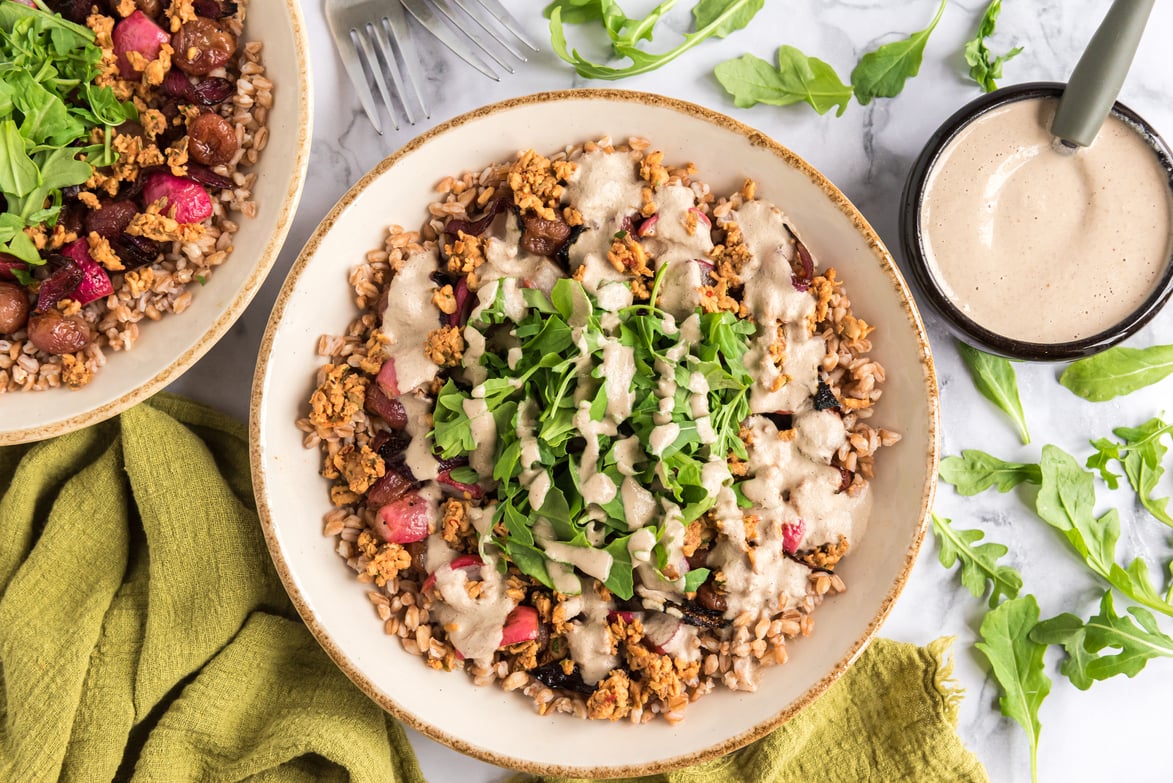 Roasting grapes is a game changer for a few reasons: They become melt-in-your-mouth soft while also becoming slightly caramelized, and the natural sweetness in grapes intensifies even more. Yum! Together with roasted balsamic red onion, radishes, and sweet, savory, and spicy Tempeh Sausage, you’ll enjoy a party of flavor in your mouth. This grain bowl is filling, nourishing, and one of the most delicious ways you can enjoy roasted grapes!
Roasting grapes is a game changer for a few reasons: They become melt-in-your-mouth soft while also becoming slightly caramelized, and the natural sweetness in grapes intensifies even more. Yum! Together with roasted balsamic red onion, radishes, and sweet, savory, and spicy Tempeh Sausage, you’ll enjoy a party of flavor in your mouth. This grain bowl is filling, nourishing, and one of the most delicious ways you can enjoy roasted grapes!
7. Charoset

This Jewish-inspired recipe uses grapes in both their dehydrated and juiced forms. Charoset is a delicious concoction of raisins, apples, almonds, walnuts, cinnamon, and dates. But soaking them in natural grape juice takes this recipe to the next level. Although there are many ways to make this sweet relish, we think our version is one of the tastiest ways to harness the flavor and nutrition of grapes!
We’re Grapeful for Grapes!
Grapes have come a long way from their origins as wine-making fodder, and are now seen as delicious in their own right. They’re sweet, juicy, convenient, and versatile, and can be enjoyed raw and cooked, fresh and frozen. To fully savor them and get the most out of their culinary potential, it’s useful to know how to select, clean, and store them.
By following the tips and guidelines provided in this article, you can ensure that every bunch of grapes you bring home brings joy to your taste buds. So whether you’re enjoying them fresh by the handful, incorporating them into delicious recipes, or exploring their frozen wonders, let grapes add a burst of natural sweetness to your life.
Tell us in the comments:
- Do you eat table grapes?
- Have you tried freezing grapes for year-round pop-in-the-mouth treats?
- Which grape recipe will you try next?
Featured Image: iStock.com/Pekic

